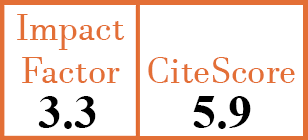Full Papers
Temporal trends in overall infection incidence in patients with inflammatory arthritides treated with tumour necrosis factor inhibitors: a nationwide cohort study
A.H. Bjornsson1, T. Thrastardottir2, B. Gudbjornsson3, T.J. Love4
- Department of Rheumatology, Skåne University Hospital, Lund, Sweden; Centre for Rheumatology Research, National University Hospital of Iceland, Reykjavik, Iceland; and School of Health Science, University of Iceland, Reykjavik, Iceland. aronhjalti@gmail.com
- School of Health Science, University of Iceland, Reykjavik, Iceland.
- Department of Rheumatology, Skåne University Hospital, Lund, Sweden; and School of Health Science, University of Iceland, Reykjavik, Iceland.
- School of Health Science, University of Iceland, Reykjavik; and Department of Science, National University Hospital of Iceland, Reykjavik, Iceland.
on behalf of ICEBIO
CER18428
2025 Vol.43, N°11
PI 1879, PF 1887
Full Papers
Free to view
(click on article PDF icon to read the article)
PMID: 40658491 [PubMed]
Received: 10/12/2024
Accepted : 02/05/2025
In Press: 04/07/2025
Published: 11/11/2025
Abstract
OBJECTIVES:
To investigate temporal trends in infection rates among patients with inflammatory arthritides receiving tumour necrosis factor inhibitors (TNFi) and explore whether the incidence of infections among patients starting TNFi treatment has changed with increasing access to TNFi.
METHODS:
In this nationwide matched cohort study, we extracted information on all adult biologic-naive patients with rheumatoid arthritis, psoriatic arthritis, and spondyloarthritides initiating treatment with a TNFi from the ICEBIO registry. Each patient was randomly matched on age, sex, and calendar time to five general population comparators. Patients were observed for two years before and after TNFi initiation. All ICD-10 infection codes and information on filled prescriptions were extracted from nationwide registries. The data were split into four-year periods, and incidence rate (IR) per 1000 patient-years and IR ratios (IRR) of serious infections (SI) and prescriptions for each period were calculated.
RESULTS:
We identified 1387 individuals initiating their first TNFi treatment in 2003–2018 and 6936 general population comparators. The between-period IRR for SI was 0.48 (0.25–0.94, p=0.03) for the TNFi-treated patients in the last period compared to the first, while it was 1.05 (0.93–1.2) for antimicrobial prescriptions. The IRR for comparators was stable for SI but increased for antimicrobial prescriptions (1.2 (1.1–1.3)).
CONCLUSIONS:
The study found that the IRR of serious infections associated with TNFi in patients with inflammatory arthritides has decreased over the years. The trend of diminishing SI incidence needs to be considered when analysing data over long periods or comparing recent research to previously published data.



